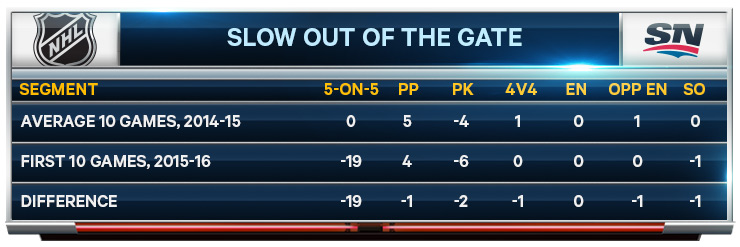From a hockey analytics standpoint, the Calgary Flames were perhaps the most interesting team in the NHL entering the 2015-16 season. Their success last season came despite some deeply unhealthy trends in their underlying numbers, but, at the same time, there were compelling reasons to think that the club would both be able to improve in some areas and continue to defy those select metrics in others.
Ten games in, there isn’t much question as to the outcome. The Flames, like the Colorado Avalanche before them, look like they’re going to be incapable of consistently outrunning their terrible five-on-five shot numbers.
That’s not to say the team’s miserable start to the year is a good reflection of its true talent. Calgary has fought through some extremely difficult injuries, has seen key players inexplicably underperform, has been hammered by a rare inability to finish off plays and by unexpectedly ghastly goaltending. Indeed, a dive into the data suggests that the Flames look much, much worse early than we should expect them to be as the year goes on.
Unfortunately, the data also suggests that this team isn’t going to win like last year’s. The things the 2014-15 Flames did that allowed them to outperform wretched Corsi figures simply aren’t evident in this year’s version of the team.
Four weeks ago, we looked at what allowed the Flames to win games while being repeatedly out-shot by the opposition. In that piece, we started by looking at goal differential; it’s worthwhile to start there again.

Obviously the big gap is at even-strength, but Calgary’s performance on the shot clock has actually improved a bit. A year ago, the Flames were out-shot 30-25 in an average hour; this year it’s 30-27. That’s still quite bad, but it’s better than last year. The trouble is that the shooting percentage has (somewhat predictably) fallen off and the goaltending has (surprisingly) imploded.
In 2014-15, a key to Calgary’s five-on-five success was a high shooting percentage; they fired at 8.9 percent. In that piece four weeks ago, we suggested the team would likely fall back to the league average, around 7.8 percent. So far, the Flames are scoring at a terrible 5.9 percent clip. Based on the volume of shots Calgary has taken so far, those numbers translate to 20 goals-for at their 2014-15 SH%, 17 at the league-average SH% and 13 at their current SH% over a 10-game span.
What we didn’t expect was the Flames’ goaltending collapse. A year ago, Calgary managed a league-average .922 five-on-five save percentage, and with both Jonas Hiller and Karri Ramo relatively established figures we expected that to continue. Instead, the team is currently sporting a .870 mark. The difference in those save percentages works out to 13 goals, more than one per game. That’s lethal for any team.
Shooting percentage will probably bounce back to around the NHL average. Calgary’s shot location profile hasn’t changed much from recent history, and outside of last season that’s what they are. Save percentage may or may not bounce back; the team isn’t allowing many more shots from dangerous areas and both Hiller/Ramo are good goalies, but these slow starts have a way of snowballing, as we’ve seen in recent years with Devan Dubnyk and Mike Smith. Rookie backup Joni Ortio may be part of the solution
Outside of goaltending, the biggest concern is that Calgary’s special teams advantage has evaporated.
A year ago, the Flames were thoroughly mediocre in five-on-five goal differential, but made up for it on special teams. A big part of the trick was that they spent two full hours more on the power play than they did on the penalty kill thanks to great team discipline. It was essential that they repeat that feat. They haven’t; instead the Flames are actually taking more penalties than they draw. Without a big special-teams edge, there’s no way a team as bad as Calgary is five-on-five can hope to compete.
Making matters worse, it was hoped this year that Calgary’s lousy penalty-kill save percentage from a year ago would improve. Instead it has deteriorated; another manifestation of the early failings of Hiller and Ramo.
The final hope for the Flames was that a combination of internal growth from their young players and external boosts from new acquisitions would improve the team. That may yet happen. Dougie Hamilton had a goal and seven shots in just 15 minutes of ice-time on Wednesday and may now be settling in. T.J. Brodie is finally back from injury, which is help both because he’s a very good defenceman and because Mark Giordano has struggled without him.
It almost certainly won’t be enough to save the season.
Even if the team grows at five-on-five, there are other problems. First, the club needs a goalie to step in and provide quality minutes, which isn’t a given. Second, it needs to regain the discipline advantage it boasted last season, and there are no signs of that happening. Third, it’s in a big hole already; a 43-23-6 run would only equal what it managed last season when Calgary just barely made the playoffs.
It’s fair to say that any team would struggle when faced with the double shooting percentage/save percentage whammy the Flames have seen so far this season. But Calgary’s existing weaknesses five-on-five have made a bad situation so much worse.

